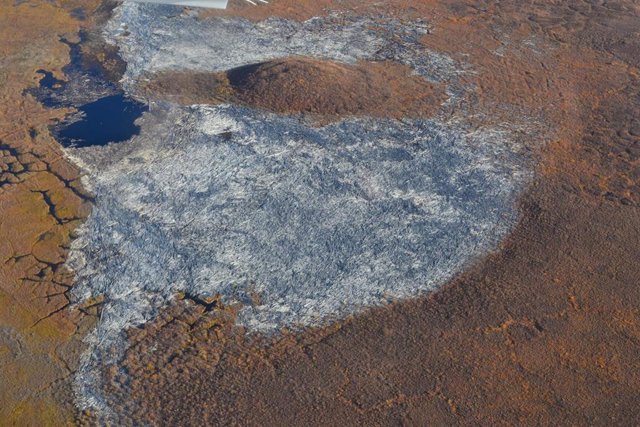12 Apr. (EUROPE PRESS) –
An enormous expanse of 51 square kilometers in the Mackenzie River delta, in northern Canada, is occupied by an accumulation of fallen trees that they store 3.4 million tons of carbon.
Its about largest known woody deposit and has just been mapped in research published by Geophysical Research Letters.
“To put that in perspective, that’s about two and a half million car emissions per year,” he said. it’s a statement Alicia Sendrowski, a research engineer who led the study while at Colorado State University. “That’s a considerable amount of carbon“He said, but it’s not a carbon pool that we know much about. “We have a lot of knowledge about carbon in other forms, like dissolved or particulate organic carbon, but not what we call ‘big carbon’ (big wood). . That’s starting to change.”
Scientists have known for decades that driftwood can actually move through the Arctic, but they’re just beginning to quantify how much wood there is, and how much of its carbon storage we risk losing to climate change. The cold, often dry or icy conditions of the Arctic mean that trees can be preserved for tens of thousands of years; a tree that fell a thousand years ago might look as fresh as one that fell last winter, Sendrowski said.
“There has been a lot of work on carbon fluxes from water and sediments, but we just didn’t pay attention to wood until very recently. This is a very young field of research that is developing quite fast,” Virginia Ruiz-Villanueva said. , a fluvial geomorphologist at the University of Lausanne who was not involved in the study. “And it’s important to study this wood not just for carbon cycling, but more broadly for our understanding of how these natural river systems work, how rivers move and distribute wood”.
To get a snapshot of the jams, Sendrowski and his colleagues focused on the Mackenzie River, which has exceptionally high-resolution images available and is known to have large deposits of timber. Its delta is the third largest in the world by land area and drains about 20% of Canada. The team surveyed some 5,000 square miles (13,000 square kilometers) of delta in the largest attempt to map woody deposits to date.
The researchers spent three weeks in the field measuring driftwood from the river with colleagues from Colorado State University, mapping the logjams and sampling the wood to date using radiocarbon dating. After fieldwork, Sendrowski used remote imaging to identify wood on the river’s surface and estimate the extent of the jam area. He then estimated the volume of wood inside the jam and how much carbon it is storing, based on his field measurements.
Sendrowski found that the deposit, which comprises more than 400,000 miniature wooden caches, stores about 3.4 million tons (3.1 million metric tons) of carbon. The largest single reservoir, covering about 20 football fields, stores 7,385 tons (6,700 metric tons) of carbon alone. But because there are even more logs buried in the ground, submerged underwater and hidden from aerial images under vegetation, the total amount of carbon stored in the delta wood could be about double, he said.
The Mackenzie River Delta is a carbon storage “hot spot” Thanks to incredibly carbon-rich soils, Sendrowski said, log carbon storage makes up a relatively small fraction of the delta’s total carbon storage, which is about 3 quadrillion grams of carbon.
“But we think it’s still important because as watershed changes like logging or dam building, and as climate change alters precipitation patterns and warming, wood conservation will decline. It’s a significant amount of carbon, so there is a potentially significant loss of carbon storage“, said.
The Mackenzie jam also reflects only one basin in the Arctic; at least a dozen deltas larger than 500 square kilometers dot the north, so all together, vast timber deposits across the Arctic could add up to be a major carbon storage reservoir, and one about which we know little.
The researchers were also interested in how long a tree can last in the Arctic, which is important when modeling how “active” a carbon pool is, that is, how fast the material moves. Carbon dating revealed that while many of the trees sampled began growing around 1950 or later, some were much older, dating back to around 700 AD



![[Img #74661]](https://thelatestnews.world/wp-content/uploads/2024/12/The-power-of-ultrasound-150x150.jpg)









![[Img #74661]](https://thelatestnews.world/wp-content/uploads/2024/12/The-power-of-ultrasound-300x200.jpg)

